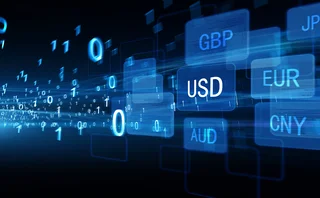Off-Exchange Equity Trades Grow in March [UPDATE]

New research from the TABB Group has shown that the level of US equity trades executing off-exchange is growing.
In a commentary note, Tales From the Dark Side: Out of Sight but Very Much in Mind, the consultancy estimates that 32.96 percent of US equities trading in March was being performed outside of registered exchanges. [Tabb originally stated the volume at 37 percent, please see note below.] By comparison, the amount in 2008 was 15 percent.
TABB attributes the recipients of the flow as internalized trading, where brokers match orders between a firm's own desks, and dark pools, taking 24 percent and 13 percent respectively.
Increasing speeds of trading, sophistication of smart order routers, decreasing volumes in the equities markets, the cost of commissions, and technological development of both dark pools and internalization engines are all cited as reasons for the growth in off-exchange trading.
"Historically, trading desks were able to match buying and selling interest received concurrently on the desk," says the commentary, written by CEO Larry Tabb and research analyst Cheyenne Morgan. "As technology now allows messages to be sent and responded to in microseconds, trading desks can send out messages to solicit the other side of the trade. If an order can't be found directly, it then moves into the firm's dark pool. If still unable to be matched, the dark pool sends messages to a wider array of market participants to trade. If still unexecuted, the order is sent to other dark pools that message a wider group of traders. If by the time the order went through two or three different dark pools and messaging cycles and the order remained unexecuted, it would then go to the exchanges. This all occurs in a fraction of a second, all managed by a series of electronic routing engines."
Exchanges, in this day and age, only get orders that almost anyone in the professional community does not want.
The commentary also suggests that, as volumes of dark liquidity grow, the US Securities Exchange Commission is likely to take a far greater interest in the inner workings of these crossing networks. It also says, while exchanges are "furious" at what is happening, and some traders are unhappy with the information leakage, most see the benefits and savings of dark execution as outweighing message weight.
"Exchanges, in this day and age, only get orders that almost anyone in the professional community does not want," Tabb and Morgan add.
[Note: There was an error made in Tabb's original report. Here is Larry Tabb's statement:
Due to an error, the March percentage of order flow traded away from exchanges should have been 32.96 percent instead of the 37 percent we reported on April 9. This did not represent a historic high. Nevertheless, the error does not invalidate the concerns expressed in our comments about the rise in off-exchange trading.]
Only users who have a paid subscription or are part of a corporate subscription are able to print or copy content.
To access these options, along with all other subscription benefits, please contact info@waterstechnology.com or view our subscription options here: http://subscriptions.waterstechnology.com/subscribe
You are currently unable to print this content. Please contact info@waterstechnology.com to find out more.
You are currently unable to copy this content. Please contact info@waterstechnology.com to find out more.
Copyright Infopro Digital Limited. All rights reserved.
As outlined in our terms and conditions, https://www.infopro-digital.com/terms-and-conditions/subscriptions/ (point 2.4), printing is limited to a single copy.
If you would like to purchase additional rights please email info@waterstechnology.com
Copyright Infopro Digital Limited. All rights reserved.
You may share this content using our article tools. As outlined in our terms and conditions, https://www.infopro-digital.com/terms-and-conditions/subscriptions/ (clause 2.4), an Authorised User may only make one copy of the materials for their own personal use. You must also comply with the restrictions in clause 2.5.
If you would like to purchase additional rights please email info@waterstechnology.com
More on Trading Tech
EMS vendors address FX options workflow bottlenecks
Volatility is driving more buy-side interest in automating exercises and allocations.
BNP Paribas explores GenAI for securities services business
The bank recently released a new web app for its client portal to modernize its tech stack.
Treasury selloff challenges back-office systems, datafeeds
FIS and Trading Technologies suffered downtime during peak activity.
Coming to America: Deutsche Börse targets US market using SimCorp One
Fresh from integrating SimCorp and rearranging its business lines, the German exchange has set American expansion as its goal for SimCorp’s buy-side offering.
Tariffs, data spikes, and having a ‘reasonable level of paranoia’
History doesn’t repeat itself, but it rhymes. Covid brought a “new normal” and a multitude of lessons that markets—and people—are still learning. New tariffs and global economic uncertainty mean it’s time to apply them, ready or not.
ICE eyes year-end launch for Treasury clearing service
Third entrant expects Q2 comment period for new access models that address ‘done-away’ accounting hurdle
MarketAxess, S&P partnership aims for greater transparency in fixed income
CP+, MarketAxess’s AI-powered pricing engine, will receive an influx of new datasets, while S&P Global Market Intelligence integrates the tool into its suite of bond-pricing solutions.
Trading Technologies looks to ‘Multi-X’ amid vendor consolidation
The vendor’s new CEO details TT’s approach to multi-asset trading, the next generation of traders, and modern architecture.







